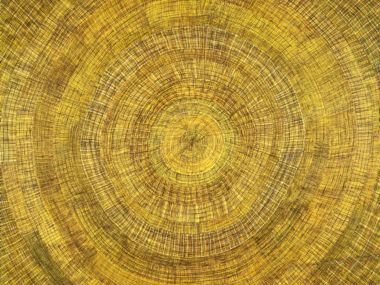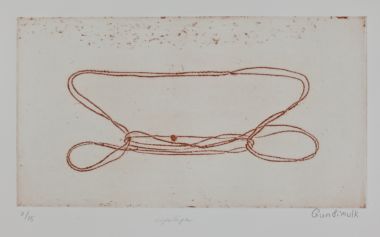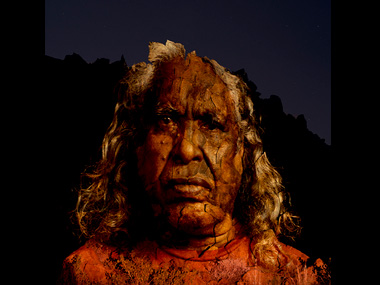STRING THEORY STRUNG

Regina Wilson's 'Sun Mat', the painting that can be a weaving in curator Barkley's words.
Posted by Jeremy Eccles | 11.10.13
Gallery: Museum of Contemporary Art
Dates:
16.08.00
: 27.10.00
It sounds as though we're off into the rarified atmospherics of quantum physics here with an exhibition called String Theory. But Museum of Contemporary Art Australia (MCA for short) curator Glenn Barkley is just toying with his audience in a very Contemporary way. For his intriguing exhibition in Sydney is defiantly low-tech – works by Aboriginal artists that all reflect the role of fibre/string/wire in the crafting of artefacts. All sorts of questions are thereby raised about the value of a painting that can also be a weaving – is it craft or art in the olde English hierarchy? - and about the point of making a Tiwi tunga out of printed paper when it's usually made of bark and used to cap Pukumani Poles as protection from the weather on those Arafura Sea islands.
Coincidentally, the two senior women inveigled into those transformations are actually the finest pure artists in the show – Regina Wilson from Peppimenarti is the painter who was denied the right to tell stories of Country by the men around her, so painstakingly painted the woven world that was her birthright; and the late great Jean Baptiste Apuatimi from the Tiwi Islands was encouraged to save trees and make multiples for her estate with the paper tunga. But as John McDonald tellingly pointed out in his Sydney Morning Herald review, the high-end Aboriginal art market continues in the doldrums – so alternative art-working is definitely the flavour of the month in the more businesslike art centres.
Perhaps one might also speculate that the women are more adaptable in such matters than their men???
But for me, the key to the exhibition is the 1948 film from Yirrkala showing the games played by Yolngu with lengths of string. Didn't we call it Cat's Cradle? Well it's clearly of greater significance in Arnhemland, where, the catalogue suggests, string may well have been a vital survival tool for the past 50,000 years. As a result, matjka , the making of string figures representing animals, their nests, landscape, plants and weather features is not just child's play, but quite as likely to be employed by a scarified, fully-initiated man. Though whether he'd have the payience to master the 192 variations that anthropologist Fred McCarthy counted in Ngarruwa Munungurr's repertoire in 1948 is only a matter of conjecture. It's believed that 192 may be more variations than any other string gamers have accumulated anywhere else in the world.
Are they still stringing people along? Well today's suite of prints showing completed string figures suggests that all is well. It would be good to see the Australian Museum making the effort to get out the 192 originals attached to cards that McCarthy brought back all those years ago.
But Glenn Barkley is a man for the present: “I would like to suggest that Aboriginal textile-based art sits at the MCA's core like a time-bomb”, he writes provocatively. “ It is a clear indication of Aboriginal art's radical ability to rupture contemporary art's trajectory....It is both folk art and contemporary art of the highest order. To use a maligned and perhaps misunderstood phrase, it is on the one hand 'outsider' – both in a formal, artistic and political sense – yet very much a vital insider (art)”.
In other wards, String Theory “smashes the notion that craft lacks validity within the contemporary gallery context”.
Ah, the curatorial essay! Sadly, this great theory runs into what I'd call the GOMA-syndrome. Big white walls have the capacity to destroy the intimacy in which much Indigenous craft/art is produced. So the curator has to encourage either aggrandissment or multiplication to make things look good.
Remember the Tjanpi Toyota? Suddenly the quirky little animals that Ngaanyatjarra women were weaving communally from grasses in the Western Desert became an Award-winning, full-size Toyota Dreaming. Now, more successfully, they've been given a whole room to weave The Seven Sisters Dreaming. And this ancient myth has become a Gothick fairy-tale, with trees that seem intent upon reaching out to clutch passers-by, and Sisters who are almost as predatory.
A clutch of Larapinta Town Camp soft sculptures share another large room with impressive lengths of hand-made string from Arnhemland, and only the donga employed to show an 'improving' animation using the sculptures really fills its space. A massive number of much smaller Noongar dolls is required to take up its necessary space. And surely Tasmanian Vicki West's bull-kelp installation was stretched beyond the natural limits of her usual decorative water-carriers?
Urban artists like Laurie Nielsen and Tony Albert find space-filling that much easier – though I'd have resisted re-showing Nielsen's Big C which was part of a noisome proppaNOW show in Cairns a year or so ago in which the Briso Boys played tediously with a passing sporting insult referring to a player as a Black C..t. Albert, on the other hand, might just find himself ejected from the Brisbane clique for looking quite so positive in his suite called Optimism – photographs in which he's making a genuine link between the traditional culture of the Rainforest bicorneal basket with everyday life today.
Talking about the revival of traditional values in the cities, the Gerringong (on NSW's South Coast) room gave great joy. For the 2000 foundation of the Boolarng Nangamal Studio has lead on to the cultivation of reeds for weaving, to international exchanges and exchanges across NSW, to courses at COFA, and to a revival in the Dharawal and Biripi cultures. Having myself observed the revival of ceremony in the very spiritual Yango area north of Sydney, I can only praise the efforts of Gerringong Gang.
You really have to approach String Theory with an enquiring, open mind – especially when encountering a museum shop in the middle of the show! Catch 'em while they're engaged! But the pop-up does allow Barkley to widen the range of his display – ghost-net baskets, for instance, a fine book selection (including, ludicrously, an English book on the Kangaroo!), lovely Regina Wilson prints and Lola Greeno Tasmanian shell necklaces, and, challengingly off-Country, genuine ochres from Mowanjum in The Kimberley.
But it's back to the Yolngu for the piece de resistance. Tucked in a dark corner (so seek it out) is the ubiquitous Frances Djulibing's work Yukuwa. It's just an installation of string and feathers. But having been tutored in the subtleties of bark-artist Djirrirra Wunungumurra's many Yukuwa paintings, I'm aware that the small yam root has a significance well beyond its size – speaking of community harmony, the umbilical links between mother and off-spring, the health of a society wracked by diabetes, and of seasonal fertility. Djulibing can also be seen on stage in Melbourne this month in an Indigenous take on King Lear – her acting career growing from the film Ten Canoes.
And finally, while we 're on film – don't miss the darkened downstairs room at the MCA featuring Craig Walsh's marvellous photos of Murujuga elders' characterful faces projected on to the ancient rocks of the Burrup Peninsular in WA. As they talk of their Country – which is physically all around you in skips – the threat to the Burrup from industrial developments by Woodside et al is never more potent.
String Theory is now on an extensive tour. It has been in Darwin and Caboolture, and next year heads for Cairns Regional Gallery 13 March – 10 May 2015, Wollongong Art Gallery 6 June – 30 August 2015 and The Glasshouse Port Macquarie 18 September – 29 November 2015.
URL: http://www.mca.com.au/touring-exhibition/string-theory-focus-contemporary-australian-art-tour/
Share this:
»  del.icio.us
»
del.icio.us
»  Digg it
»
Digg it
»  reddit
»
reddit
»  Google
»
Google
»  StumbleUpon
»
StumbleUpon
»  Technorati
»
Technorati
»  Facebook
Facebook
Contact Details
Gallery: Museum of Contemporary Art
Contact: Curator, Aboriginal and Torres Strait Islander Programs
Telephone: +61 2 9245 2400
Address: Circular Quay West George Street The Rocks Sydney 2000 NSW
Gallery: Museum of Contemporary Art
Contact: Curator, Aboriginal and Torres Strait Islander Programs
Telephone: +61 2 9245 2400
Address: Circular Quay West George Street The Rocks Sydney 2000 NSW

Gundimulk Wanambi's print of a Yirrkala string figure, 'Lipa Lipa' (Canoe) 2010

The mighty Lawrence Kerr, Murujuga elder, projected on to and becoming part of Burrup Peninsular's rock art courtesy of Craig Walsh
Where is the exhibition?
Further Research
Gallery: Museum of Contemporary Art
Artists: Laurie Nielsen | Djirrirra Wunungumurra | Frances Djulibing | Jean Baptiste Apuatimi | Lola Greeno | Regina Wilson | Tony Albert | Vicki West
News Tags: Burrup Peninsular | Glenn Barkley | Jeremy Eccles | MCA | Museum of Contemporary Art | String Theory
News Categories: Australia | Blog | Exhibition | Feature | Industry | News
Exhibition Archive
- 10.10.17 | TARNANTHI 2017
- 11.08.17 | Natsiaas 2017
- 20.07.17 | APY ART DOMINATES THE WYNNE
- 17.07.17 | Anangu Artist Wins $100,000 Prize
- 14.07.17 | The End of AAMU
- 11.07.17 | ART ACROSS THE COUNTRY
- 11.07.17 | TARNANTHI IN OCTOBER
- 05.07.17 | TJUNGUṈUTJA - from having come together
- 13.06.17 | Ghost-Nets Straddle the World
- 07.06.17 | Grayson Perry Going Indigenous?
- 05.06.17 | Barks Bigger than Ben Hur
- 27.05.17 | NGA QUINQUENNIAL 2017
- 21.05.17 | Blak Douglas Finds Home at the NGA
- 21.05.17 | BRIAN ROBINSON WINS HAZELHURST WOP
- 18.05.17 | PARRTJIMA 2.0
Advertising

